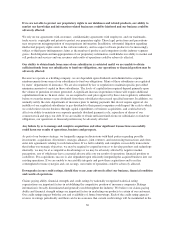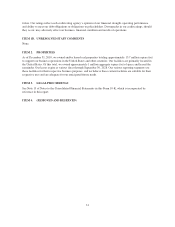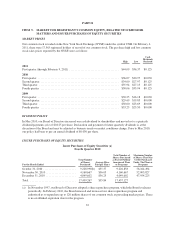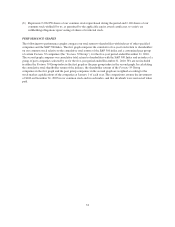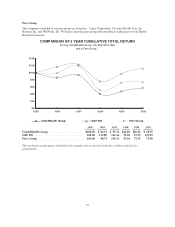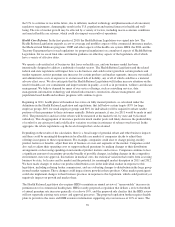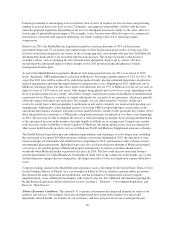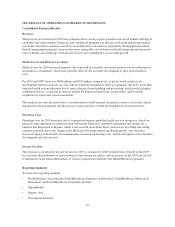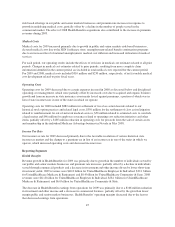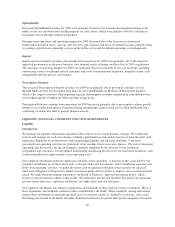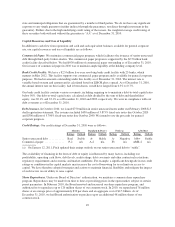United Healthcare 2010 Annual Report Download - page 41
Download and view the complete annual report
Please find page 41 of the 2010 United Healthcare annual report below. You can navigate through the pages in the report by either clicking on the pages listed below, or by using the keyword search tool below to find specific information within the annual report.the U.S. to continue to rise in the future, due to inflation, medical technology and pharmaceutical advancement,
regulatory requirements, demographic trends in the U.S. population and national interest in health and well-
being. The rate of market growth may be affected by a variety of factors, including macro-economic conditions
and enacted health care reforms, which could also impact our results of operations.
Health Care Reforms. In the first quarter of 2010, the Health Reform Legislation was signed into law. The
Health Reform Legislation expands access to coverage and modifies aspects of the commercial insurance market,
the Medicaid and Medicare programs, CHIP and other aspects of the health care system. HHS, the DOL and the
Treasury Department have issued regulations (or proposed regulations) on a number of aspects of Health Reform
Legislation, but we await final rules and interim guidance on other key aspects of the legislation, all of which
have a variety of effective dates.
We operate a diversified set of businesses that focus on health care, and our business model has been
intentionally designed to address a multitude of market sectors. The Health Reform Legislation and the related
federal and state regulations will impact how we do business and could restrict growth in certain products and
market segments, restrict premium rate increases for certain products and market segments, increase our medical
and administrative costs or expose us to an increased risk of liability, any or all of which could have a material
adverse effect on us. We also anticipate that the Health Reform Legislation will further increase attention on the
need for health care cost containment and improvements in quality, as well as in prevention, wellness and disease
management. We believe demand for many of our service offerings, such as consulting services, data
management, information technology and related infrastructure construction, disease management, and
population-based health and wellness programs will continue to grow.
Beginning in 2011, health plans with medical loss ratios on fully insured products, as calculated under the
definitions in the Health Reform Legislation and regulations, that fall below certain targets (85% for large
employer groups, 80% for small employer groups and 80% for individuals) will be required to rebate ratable
portions of their premiums to their customers annually. Rebate payments, if any, for 2011 would be made in mid
2012. The potential for and size of the rebates will be measured at the market level, by state and by licensed
subsidiary. This disaggregation of insurance pools into much smaller pools will likely decrease the predictability
of results for any given pool and could lead to variation over time in estimates of rebates owed in total. In the
aggregate, the rebate regulations cap the level of margin that can be attained.
Depending on the results of the calculation, there is a broad range of potential rebate and other business impacts
and there could be meaningful disruption in local health care markets if companies decide to adjust their
offerings in response to these requirements. For example, companies could elect to change pricing, modify
product features or benefits, adjust their mix of business or even exit segments of the market. Companies could
also seek to adjust their operating costs to support reduced premiums by making changes to their distribution
arrangements or decreasing spending on non-medical product features and services. Companies continue to face
a significant amount of uncertainty given the breadth of possible changes, including changes in the competitive
environment, state rate approval, fluctuations in medical costs, the statistical variation that results from assessing
business by state, by license and by market and the potential for meaningful market disruption in 2011 and 2012.
We have made changes to reduce our product distribution costs in the individual market in response to this
legislation, including reducing broker commissions, and are evaluating changes to distribution in the large group
insured market segment. These changes could impact future growth in these products. Other market participants
could also implement changes to their business practices in response to this legislation, which could positively or
negatively impact our growth and market share.
The Health Reform Legislation also requires HHS to maintain an annual review of “unreasonable” increases in
premium rates for commercial health plans. HHS recently proposed a regulation that defines a review threshold
of annual premium rate increases generally at or above 10%, and the proposed rule clarifies that the HHS review
will not supersede existing state review and approval processes. The proposed regulation further requires health
plans to provide to the states and HHS extensive information supporting any rate increase of 10% or more. The
39



